Artist: Warsan Mohammed
Curator: Anna Emina El Samad
Exhibition details: SchoolHouse Gallery, 12 – 25 November
The walls of SchoolHouse Gallery are painted green and brown. I catch a glimpse of this through the window of the gallery, which looks out onto the SchoolHouse parking lot from where I stand. It is the first time I’ve seen any other colour but white painted on the gallery walls—the signature mark of curator Anna Emina El Samad, who leaves behind a streak of expressive and experimental colour wherever she goes. When she curated The Window earlier this year, Anna Emina matched the pinks and purples in the paintings of exhibiting artist Amani Haydar with a vibrant fruit and floral display in the centre of the gallery.
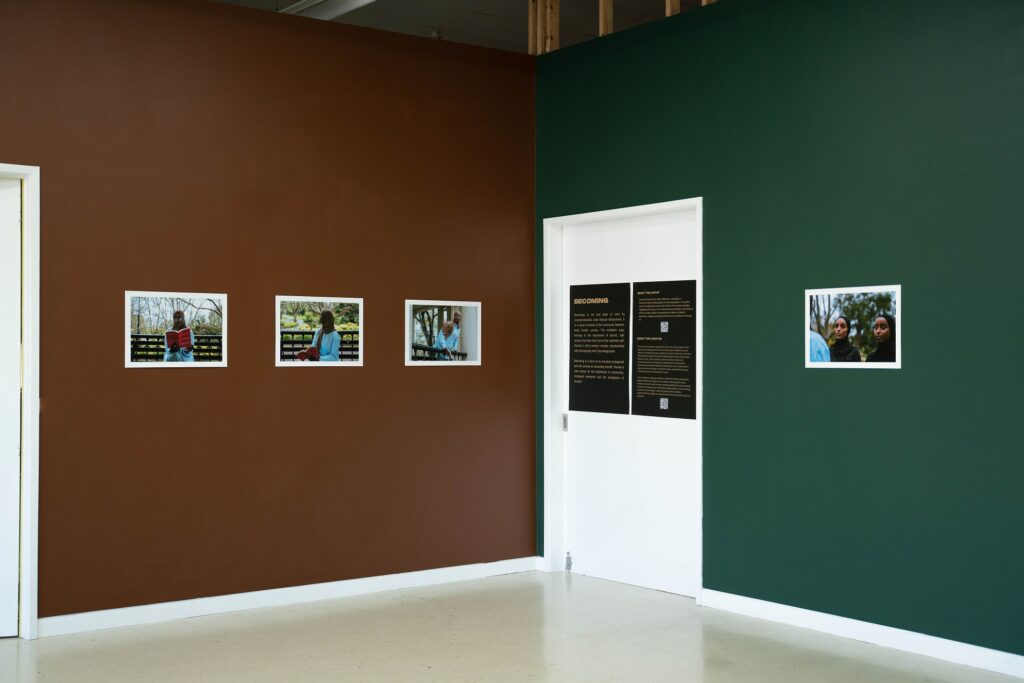
Green and brown walls frame Becoming, a new exhibition curated by Anna Emina, and the first solo exhibition of Somali-Australian photographer and cinematographer Warsan Mohammed. Becoming is inspired by the communities created by Black Muslim women and the safe spaces they provide to grow spiritually in culture and find self-acceptance. As a new body of work, Becoming not only portrays relationships between Black Muslim women, but also illuminates the foundation of Warsan’s work: to centre her community in her practice, and to instil an example of self-love for younger generations.
Warsan was one of the few Black Muslim students at her school in Melbourne’s Inner-North. She tells me that she was not the same person then as she is now. When she found her community as a young adult it encouraged her unrelenting confidence to bloom. It is difficult for me to imagine Warsan as anything but certain in her faith and Blackness—it glows from within her.
Black Muslim women are at the intersection of multiple marginalised communities in Australia, facing a Western gaze that vilifies Islam, oppresses Black people and subjugates women. The safe spaces created by Black Muslim women, depicted by Warsan in Becoming, are an act of resistance to this Western worldview. They reject being pigeonholed by a white lens, instead engaging in social, critical and religious discourse together. They also accomplish this by simply existing as a unified identity that centres faith, culture and sisterhood in every element of life. Becoming portrays the importance of these spaces wherein Black Muslim women grow within themselves and mirrors Warsan’s personal journey to self-acceptance.
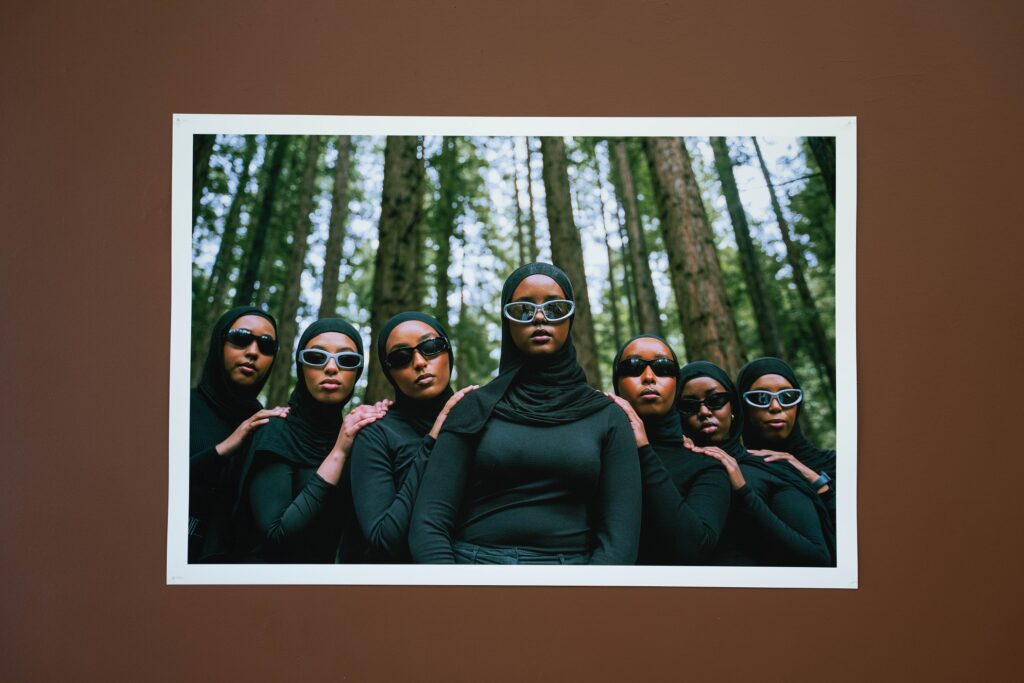
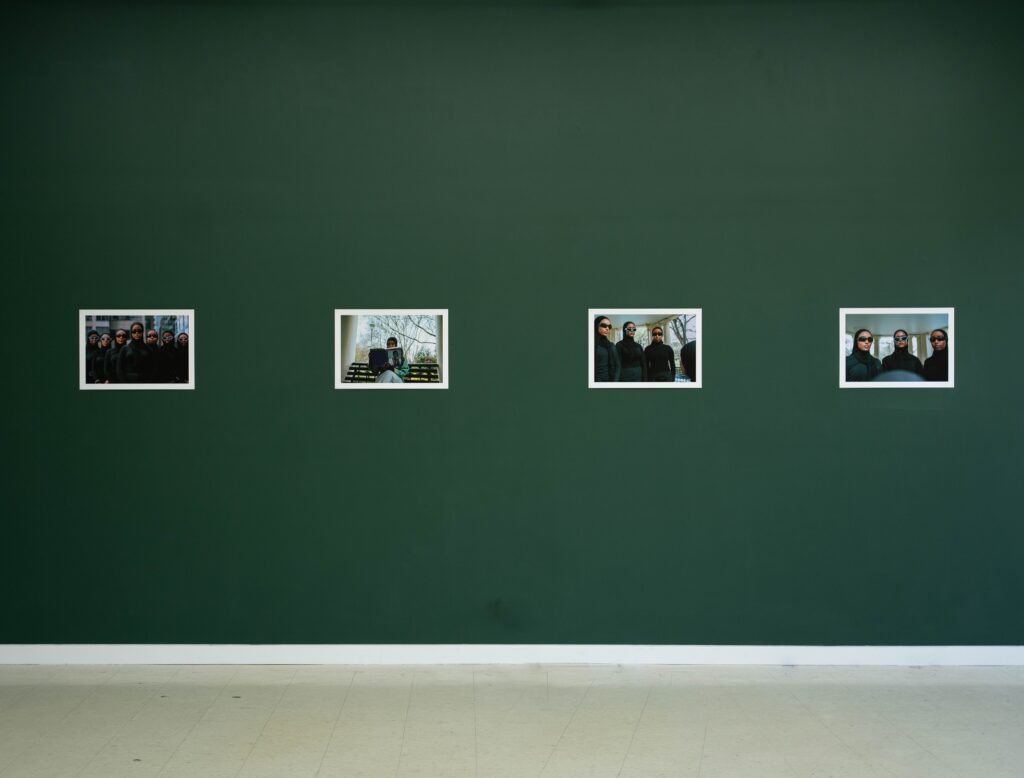
The sixteen images that comprise Becoming hang in chronological order in the gallery, creating a visual narrative like stills from a movie. Each image represents a different stage in the unnamed protagonist’s journey. The narrative is as follows: a young Black Muslim woman sits alone at a park bench reading where she is approached by a group of six women. Taking the protagonist under their wing the women shower her in love and initiate her into the group. As the narrative progresses, their support eventually leads the protagonist to become a leader and initiate another young woman to join their community, beginning the cycle again.
Becoming #5 marks the turning point in the protagonist’s journey as she ventures from lone individual to community leader. With her back to the audience, the protagonist stands facing the six women, looking forward towards the future, leaving her life alone behind. Her blue jacket is in contrast against the black clothing of the other women, who don their attire like a uniform of the community. Like a swaddle around a newborn, the jacket acts as a symbol of youth and new beginnings, protecting the protagonist against the possibility of the unknown until the sisterhood bond has been cemented.
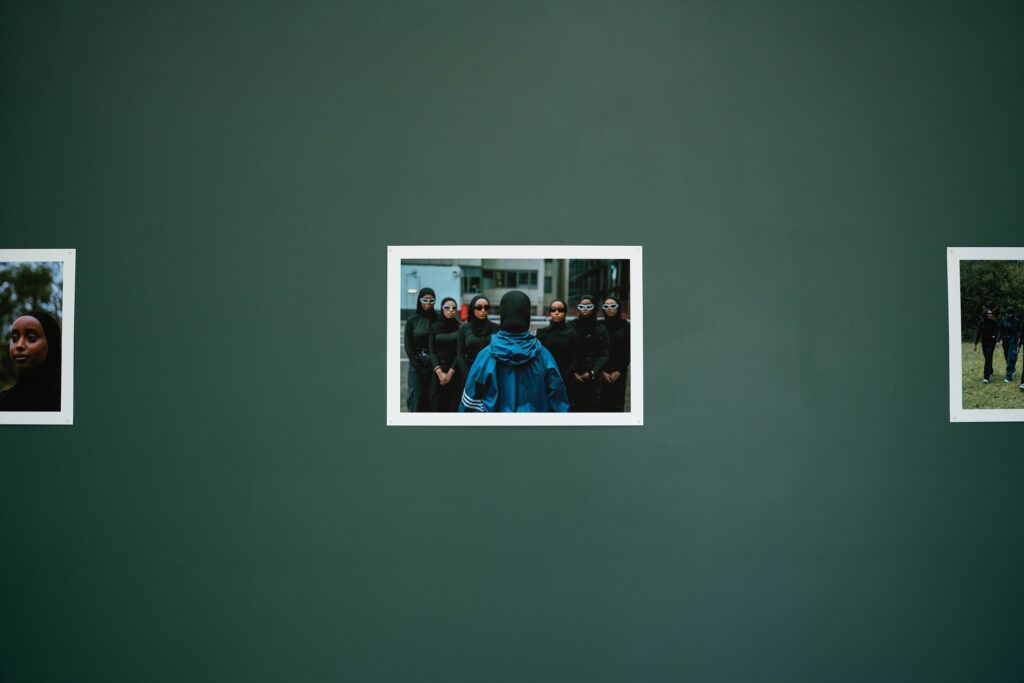
Her initiation into the community commences in Becoming #7, the last appearance of the blue jacket and a defining moment in the women’s growing companionship. The protagonist’s demeanour has softened, where she once stood stiff in Becoming #5 she now sits relaxed, drinking tea and laughing with the other women as they sit in a circle. I think about the way Warsan found her community in Halaqa circles, and I think about the way women in my culture sit in circles with each other. Sometimes we talk about God, sometimes we talk about cooking, all the time we talk about family. The act of women sitting together as a means to grow in culture and religion is a common ground Warsan and I share. For both of us, it is healing.
I remember in university a peer spoke to me about symmetry in Islamic art as a symbol of harmony and perfection. She said this in reference to her work, which recreated the circular patterns of pilgrims walking around the Kaaba during Hajj. This was my first thought upon seeing Becoming #10. The symmetry in this image, while not mathematically perfect, depicts a perfect moment of community. Five women and the protagonist embrace while standing in a circle, their heads bowed, temples touching and hands resting on each other’s shoulders. They lean on each other for support – the comfort of this hug reaffirms their bond, and if one were to leave the others would fall.
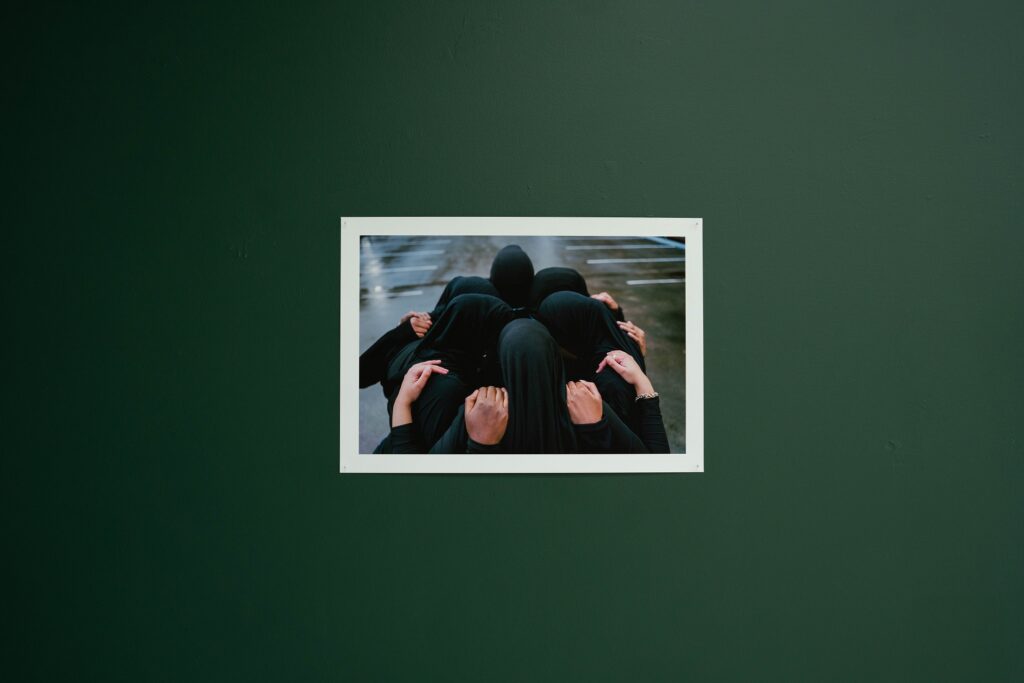
The physical affection continues with the concluding image Becoming #16, which represents the protagonist as leader of her community. Front and centre, the protagonist stands with three women on either side, who place one hand on the shoulder of the person in front of them. In a similar manner to Becoming #10, the emotional and physical support provided by each woman upholds the strength of the entire community. I feel my heart swell when I look at this image, a sense of pride towards the women who uphold their leader, and the protagonist, whose journey I have finished watching.
Curatorially, Becoming utilises colour to extend the images beyond their border. The greens and browns that live in Warsan’s images are extended across the walls in similar tones. They are not only a designed curatorial device, but an extension of the artist and curator relationship—Warsan’s favourite colour is brown and Anna Emina’s is green.
When the three of us recently sat down to discuss how the concept of Becoming developed, Warsan said of Anna Emina:
'Allah puts people in your life when you need them most'
I reflected on this, of course, in regard to their relationship and how they met at a time Warsan needed most, but also in reference to the relationships depicted in Becoming.
How we meet new people can be easily explained, but the unexpected and profound impact they have on our lives remains a Dues Ex Machina type of mystery. Becoming is a thank you letter to the Black Muslim women that shaped and inspired Warsan’s confidence. It is a thank you to God for putting Warsan and Anna Emina at the University of Melbourne musalla at the same time one year ago. And it is a prayer for the young Black Muslim girls who view Becoming, to find a community that they can call home.
Celine Saoud is a second generation Lebanese-Australian writer and emerging curator based in Naarm. Her practice revives cultural and familial traditions within modern frameworks. Celine is continuously inspired by the way matriarchs, family and community relationships shape cultural practices.
In 2021 Celine graduated from Monash University with a Bachelor of Art History and Curating. Her graduate curatorial project ‘Klakeesh’ was awarded the 2021 MUMA/BAHC Curatorial Training Program. Currently, Celine works as an Exhibition Assistant across RMIT Galleries and is a resident at SchoolHouse Studios.
This text was commissioned through the Emerging Writers’ Program. An annual collaborative project, from KINGS and un Projects, that supports critical arts writing, fiction, poetry, experimental, cross-genre and digital text forms. The Emerging Writers’ Program provides professional publishing opportunities and fosters dialogue between artists and arts writers. Each emerging writer in the program receives critical feedback and editorial assistance from KINGS and un Projects personnel.
In 2022, the KINGS X un Projects Emerging Writer’s Program is supported by Creative Victoria through their Sustaining Creative Workers initiative.
